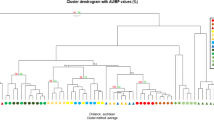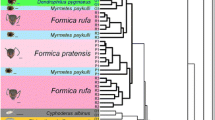Abstract
A vast diversity of parasites associates with ants. Living in and around ant nests of these organisms must overcome ant colony defenses. As ant defensive behavior is mainly mediated by species-specific cuticular hydrocarbons (CHCs) or alarm pheromones, and ant-associated parasites can either crack their hosts’ chemical communication code by modifying their own CHC profiles or use pro-active strategies like chemical weaponry for distraction and repellency. While the chemical nature of ant–parasite interactions has been intensively studied for highly host-specific parasites, the chemical-deceptive strategies of the rather rare ant-resembling heteropterans are unknown. To gain insight into this system, I studied the bug Scolopostethus pacificus (Barber 1918) which can be found near the nests of the ecologically dominant and aggressive velvety tree ant (Liometopum occidentale, Emery 1895). Using behavioral, chemical, and molecular approaches, I disentangled the relationship of S. pacificus and its host ant. Chemical profiling of the bug and the ant revealed that the bug does not make use of CHC insignificance or mimicry, but instead uses a cocktail of volatile compounds released from its metathoracic glands that likely moderates encounters with its aggressive host. Feeding trials with armed and artificially disarmed bugs revealed a defensive function of the gland exudates. Targeted molecular gut barcoding showed that S. pacificus does not feed on L. occidentale. These results suggest that chemical weaponry, rather than a chemical code-cracking CHC matching or chemical insignificance, enables S. pacificus to get along with and live in close proximity to its host ant.



Similar content being viewed by others
References
Akino T (2008) Chemical strategies to deal with ants: a review of mimicry, camouflage, propaganda, and phytomimesis by ants (Hymenoptera: Formicidae) and other arthropods. Myrmecol News 11:173–181
Aldrich J (1988) Chemical ecology of the Heteroptera. Annu Rev Entomol 33:211–238
Bagnères A-G, Lorenzi MC (2010) Chemical deception/mimicry using cuticular hydrocarbons Insect hydrocarbons. Biol Biochem Chem Ecol. https://doi.org/10.1017/CBO9780511711909.015
Barber H (1918) Concerning Lygaeidae. No. 2. J NY Entomol Soc 26:49–66
Benjamini Y, Hochberg Y (1995) Controlling the false discovery rate—a practical and powerful approach to multiple testing. J R Stat Soc Series B 57:289–300
Blomquist GJ, Bagnères A-G (2010) Insect hydrocarbons. Cambridge University Press, Cambridge
Brückner A, Heethoff M (2017) A chemo-ecologists’ practical guide to compositional data analysis. Chemoecology 27:33–46
Brückner A, Hoenle PO, von Beeren C (2018) Comparative chemical analysis of army ant mandibular gland volatiles (Formicidae: Dorylinae). PeerJ 6:e5319
Carlson DA, Roan CS, Yost RA, Hector J (1989) Dimethyl disulfide derivatives of long chain alkenes, alkadienes, and alkatrienes for gas chromatography/mass spectrometry. Anal Chem 61:1564–1571
Carlson DA, Bernier UR, Sutton BD (1998) Elution patterns from capillary GC for methyl-branched alkanes. J Chem Ecol 24:1845–1865
Cushing PE (1997) Myrmecomorphy and myrmecophily in spiders: a review. Florida Entomologist 80(2):165–193
Cushing PE (2012) Spider-ant associations: an updated review of myrmecomorphy, myrmecophily, and myrmecophagy in spiders. Psyche. https://doi.org/10.1155/2012/151989
Dani FR, Jones GR, Destri S, Spencer SH, Turillazzi S (2001) Deciphering the recognition signature within the cuticular chemical profile of paper wasps. Anim Behav 62:165–171
Danoff-Burg JA (1994) Evolving under myrmecophily: a cladistic revision of the symphilic beetle tribe Sceptobiini (Coleoptera: Staphylinidae: Aleocharinae). System Entomol 19:25–45
Danoff-Burg JA (2002) Evolutionary lability and phylogenetic utility of behavior in a group of ant-guest Staphylinidae beetles. Ann Entomol Soc Am 95:143–155
Dettner K, Liepert C (1994) Chemical mimicry and camouflage. Ann Rev Entomol 39:129–154
D’Ettorre P, Errard C, Ibarra F, Francke W, Hefetz A (2000) Sneak in or repel your enemy: Dufour’s gland repellent as a strategy for successful usurpation in the slave-maker Polyergus rufescens. Chemoecology 10:135–142
Duffey S, Scudder G (1974) Cardiac glycosides in Oncopeltus fasciatus (Dallas)(Hemiptera: Lygaeidae). I. The Uptake and Distribution of Natural Cardenolides in the Body Canadian. J Zool 52:283–290
Gotwald WH Jr (1995) Army ants: the biology of social predation. Cornell University Press
Greene MJ, Gordon DM (2007) Structural complexity of chemical recognition cues affects the perception of group membership in the ants Linephithema humile and Aphaenogaster cockerelli. J Exp Biol 210:897–905
Guillem RM, Drijfhout F, Martin SJ (2014) Chemical deception among ant social parasites Current. Zoology 60:62–75
Hammer Ø, Harper DAT, Ryan PD (2001) PAST: Paleontological statistics software package for education and data analysis. Palaeontol Electron 4:9
Hoey-Chamberlain R, Rust MK, Klotz JH (2013) A review of the biology, ecology and behavior of velvety tree ants of North America. Sociobiology 60:1–10
Hölldobler B, Wilson EO (1990) The ants. Harvard University Press
Howard RW, Blomquist GJ (2005) Ecological, behavioral, and biochemical aspects of insect hydrocarbons. Annu Rev Entomol 50:371–393
Jeral JM, Breed MD, Hibbard BE (1997) Thief ants have reduced quantities of cuticular compounds in a ponerine ant, Ectatomma Ruidum. Physiol Entomol 22:207–211
Ji YJ, Zhang DX, He LJ (2003) Evolutionary conservation and versatility of a new set of primers for amplifying the ribosomal internal transcribed spacer regions in insects and other invertebrates. Mol Ecol Notes 3:581–585
Johnson CA, Vander Meer RK, Lavine B (2001) Changes in the cuticular hydrocarbon profile of the slave-maker ant queen, Polyergus breviceps Emery, after killing a Formica host queen (Hymenoptera: Formicidae). J Chem Ecol 27:1787–1804
Kather R, Martin SJ (2015) Evolution of cuticular Hydrocarbons in the Hymenoptera: a meta-analysis. J Chem Ecol 41:871–883
Kistner DH (1981) Social and evolutionary significance of social insect symbionts. Soc Insects 1:339–413
Kistner DH (1982) The social insects’ bestiary. Soc Insects 3:1–244
Kleineidam CJ, Heeb EL, Neupert S (2017) Social interactions promote adaptive resource defense in ants. PLoS ONE 12:e0183872
Krajicek J et al (2016) Comparative analysis of volatile defensive secretions of three species of Pyrrhocoridae (Insecta: Heteroptera) by gas chromatography-mass spectrometric method. PLoS ONE 11:e0168827
Krall BS, Bartelt RJ, Lewis CJ, Whitman DW (1999) Chemical defense in the stink bug Cosmopepla bimaculata. J Chem Ecol 25:2477–2494
Kronauer DJ, Pierce NE (2011) Myrmecophiles Current Biology 21:R208–R209
Larson DJ, Scudder G (2018) Seed Bugs and their allies (Hemiptera: Heteroptera: Lygaeoidea) of the Canadian Prairie Provinces Canadian Journal of Arthropod Identification
Lenoir A, d’Ettorre P, Errard C, Hefetz A (2001) Chemical ecology and social parasitism in ants. Ann Rev Entomol 46:573–599
Martin S, Drijfhout F (2009) A review of ant cuticular hydrocarbons. J Chem Ecol 35:1151
Martin SJ, Takahashi J-i, Ono M, Drijfhout FP (2008) Is the social parasite Vespa dybowskii using chemical transparency to get her eggs accepted? J Insect Physiol 54:700–707
Martin SJ, Helanterä H, Drijfhout FP (2011) Is parasite pressure a driver of chemical cue diversity in ants? Proc R Soc B 278:496–503
Maruyama M, Parker J (2017) Deep-time convergence in rove beetle symbionts of army ants. Curr Biol 27:920–926
Menzel F, Blaimer BB, Schmitt T (2017) How do cuticular hydrocarbons evolve? Physiological constraints and climatic and biotic selection pressures act on a complex functional trait. Proc R Soc B 284:20161727
Moreira JA, Millar JG (2005) Short and simple syntheses of 4-oxo-(E)-2-hexenal and homologs: pheromone components and defensive compounds of Hemiptera. J Chem Ecol 31:965–968
Naragon TH, Wagner JM, Parker J (2022) Parallel evolutionary paths of rove beetle myrmecophiles: replaying a deep-time tape of life. Curr Opin Insect Sci 51:100903
Neupert S, DeMilto A, Drijfhout F, Speller S, Adams RM (2018) Host colony integration: Megalomyrmex guest ant parasites maintain peace with their host using weaponry. Anim Behav 139:71–79
Parker J (2016) Myrmecophily in beetles (Coleoptera): evolutionary patterns and biological mechanisms. Myrmecol News 22:65–108
Parker J, Grimaldi DA (2014) Specialized myrmecophily at the ecological dawn of modern ants. Curr Biol 24:2428–2434
Parmentier T (2020) Guests of social insects. In: Encyclopedia of Social Insects. Springer
Parmentier T, Dekoninck W, Wenseleers T (2014) A highly diverse microcosm in a hostile world: a review on the associates of red wood ants (Formica rufa group). Insectes Soc 61:229–237
Parmentier T, Dekoninck W, Wenseleers T (2017) Arthropods associate with their red wood ant host without matching nestmate recognition cues. J Chem Ecol 43:644–661
Pekár S, Jiroš P (2011) Do ant mimics imitate cuticular hydrocarbons of their models? Anim Behav 82:1193–1199
Polidori C, Geyer M, Schmitt T (2020) Do Sphecodes cuckoo bees use chemical insignificance to invade the nests of their social Lasioglossum bee hosts? Apidologie 51:147–162
Post DC, Jeanne RL (1981) Colony defense against ants by Polistes fuscatus (Hymenoptera: Vespidae) in Wisconsin. J Kansas Entomol Soc 54(3):599–615
R Core Team (2019) R: A language and environment for statistical computing. R Foundation for Statistical Computing, Vienna
Schuh RT, Slater JA (1995) True bugs of the world (Hemiptera: Heteroptera): classification and natural history. Cornell University Press
Slater JA, Carayon J (1963) Ethiopian Lygaeidae IV: a new predatory Lygaeid from Africa with a discussion of its biology and morphology (Hemiptera: Heteroptera). In: Proceedings of the Royal Entomological Society of London. Series A, General Entomology, vol 1–3. Wiley Online Library, pp 1–11
Thiel T, Brechtel A, Brückner A, Heethoff M, Drossel B (2018) The effect of reservoir-based chemical defense on predator-prey dynamics. Theor Ecol. Theor Ecol 12(3):365–378
Uboni A, Bagnères A-G, Christidès J-P, Lorenzi MC (2012) Cleptoparasites, social parasites and a common host: chemical insignificance for visiting host nests, chemical mimicry for living in. J Insect Physiol 58:1259–1264
von Beeren C, Schulz S, Hashim R, Witte V (2011) Acquisition of chemical recognition cues facilitates integration into ant societies. BMC Ecol 11:30
von Beeren C, Pohl S, Witte V (2012) On the use of adaptive resemblance terms in chemical ecology. Psyche. https://doi.org/10.1155/2012/635761
von Beeren C, Brückner A, Maruyama M, Burke G, Wieschollek J, Kronauer DJ (2018) Chemical and behavioral integration of army ant-associated rove beetles–a comparison between specialists and generalists. Front Zool 15:8
Wasmann E (1894) Kritisches Verzeichniss der myrmekophilen und termitophilen Arthropoden: Mit Angabe der Lebensweise und mit Beschreibung neuer Arten. FL Dames,
Yasuda T, Shigehisa S, Yuasa K, Okutani-Akamatsu Y, Teramoto N, Watanabe T, Mochizuki F (2008) Sex attractant pheromone of the sorghum plant bug Stenotus rubrovittatus (Matsumura)(Heteroptera: Miridae). Appl Entomol Zool 43:219–226
Acknowledgements
Thanks to Joe Parker and Mina Yousefelahiyeh for discussion and technical assistance, respectively. Steven Wilbert contributed pictures, Tom Naragon kindly provided Platyusa sonomae from his lab cultures, and Betty Hong supplied analytical standards. Christiane Weirauch (UC Riverside) identified the bug species. Christoph von Beeren and Tom Naragon critically reviewed and commented on an earlier version of the manuscript. I was a Simons Fellow of the Life Sciences Research Foundation (LSRF) when I performed the research presented in this study.
Funding
This research was supported by Simons Foundation (Grant LSRF-AB-2018).
Author information
Authors and Affiliations
Corresponding author
Ethics declarations
Conflict of interest
The authors have not disclosed any competing interests.
Ethics statement
There are no legal restrictions on working with the herein mentioned species. Field collection permissions were issues by California Department of Fish and Wildlife and the Angeles National Forest (US Forest Service; USDA).
Additional information
Communicated by Günther Raspotnig.
Supplementary Information
Below is the link to the electronic supplementary material.
Rights and permissions
About this article
Cite this article
Brückner, A. Using weapons instead of perfume: chemical association strategies of the myrmecophilous bug Scolopostethus pacificus (Rhyparochromidae). Chemoecology 32, 147–157 (2022). https://doi.org/10.1007/s00049-022-00374-8
Received:
Accepted:
Published:
Issue Date:
DOI: https://doi.org/10.1007/s00049-022-00374-8




